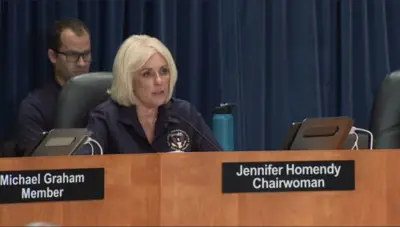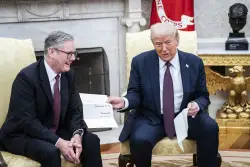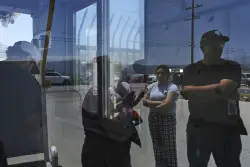Night vision goggles may have hampered helicopter pilots before crash with jet, experts tell NTSB

AP The pilots of a U S Army helicopter that collided with a customer jet over Washington in January would ve had difficulty spotting the plane while wearing night vision goggles experts communicated the National Transportation Safety Board on Friday The Army goggles would have made it laborious to see the plane s colored lights which might have helped the Black Hawk determine the plane s direction The goggles also limited the pilots peripheral vision as they flew near Ronald Reagan Washington National Airport The challenges posed by night-vision goggles were among the topics discussed at the NTSB s third and final day of constituents testimony over the fatal midair crash which killed all people aboard both aircrafts Experts announced another challenge that evening was distinguishing the plane from lights on the ground while the two aircraft were on a collision program Plus the helicopter pilots may not have known where to look for a plane that was landing on a secondary runway that largest part planes didn t use Knowing where to look That s key declared Stephen Casner an expert in human factors who used to work at NASA Two previous days of testimony underscored a number of factors that likely contributed to the collision sparking Board Chairwoman Jennifer Homendy to urge the Federal Aviation Administration to do better as she pointed to warnings the agency had ignored years earlier A few of the major issues that have emerged so far include the Black Hawk helicopter flying above prescribed levels near the airport as well as the warnings to FAA bureaucrats for years about the hazards related to the heavy chopper traffic there It s too early for the board to identify what exactly caused the crash A final overview from the board won t come until next year But it became clear this week how small a margin of error there was for helicopters flying the trail the Black Hawk took the night of the nation s deadliest plane crash since November The American Airlines jet arrived from Wichita Kansas carrying among others a group of elite young figure skaters their parents and coaches and four union steamfitters from the Washington area The collision was the first in a string of crashes and near misses this year that have alarmed agents and the traveling populace despite statistics that still show flying remains the safest form of transportation Vital frustration NTSB members scolded FAA authorities during Friday s hearing accusing them of saying the right things about safety in residents while failing to cooperate in private They announced the FAA has repeatedly refused to provide information requested by investigators Board member Todd Inman mentioned there was vital frustration between what s veritably occurring and what s being mentioned for citizens consumption Frank McIntosh the head of the FAA s air traffic control organization explained he would start working right away to remove those impediments McIntosh also acknowledged problems with the way of life in the tower at Reagan National despite past efforts to improve compliance with safety standards I think there were chosen things that we missed to be quite honest with you not intentionally but I was talking about how certain facilities can drift McIntosh disclosed Questions over lack of alcohol testing Tim Lilley an aviation expert whose son Sam was a pilot on the customer jet declared he s optimistic the tragic accident will ultimately lead to particular positive changes But we ve got a long way to go he stated The Associated Press Lilley announced he was particularly struck by the FAA s lack of alcohol testing for air traffic controllers after the crash And they made a bunch of excuses why they didn t do it Lilley revealed None of them were valid It goes back to a whole system that was complacent and was normalizing deviation Homendy declared during Thursday s hearings that alcohol testing is largest part effective within two hours of a crash and can be administered within eight hours Nick Fuller the FAA s acting deputy chief operating officer of operations testified that the controllers weren t tested because the agency did not forthwith believe the crash was fatal The FAA then decided to forgo it because the optimum two-hour window had passed Controller didn t warn the jet FAA officers testified this week that an air traffic controller should have warned the customer jet of the Army helicopter s presence The controller had sought the Black Hawk pilots to confirm they had the airplane in sight because an alarm sounded in the tower about their proximity The controller could see from a window that the helicopter was too close but the controller did not alert the jetliner In a transcript circulated this week the unidentified controller noted in a post-crash interview they weren t sure that would have changed the outcome Additionally the pilots of the helicopter did not fully hear the controller s instructions before the collision When the controller recounted the helicopter s pilots to pass behind the jet the crew didn t hear it because the Black Hawk s microphone key was pressed at that moment Layer after layer of deficiencies Jeff Guzzetti a former NTSB and FAA crash investigator stated the AP that a combination of factors produced this tragedy like holes that line up in the Swiss cheese Any number of things had they been different could have prevented the collision he disclosed They include the Black Hawks having more accurate altimeters as well as a key piece of locating equipment known as ADS-B Out turned on or working In turn air traffic control could have seen the dilemma earlier Just a sparse feet could have made a difference Guzzetti stated It just goes to show you that an accident isn t caused by one single thing Guzzetti mentioned It isn t caused by pilot error or controller staffing This accident was caused by layer after layer of deficiencies that piled up at just the right moment Ex-official FAA and Army share blame Mary Schiavo a former U S Department of Transportation Inspector General advised the AP that both the Army and the FAA appear to share notable blame The Black Hawks altimeters could be off by as much as feet and were still considered acceptable she reported The crew was flying an outdated model that struggled to maintain altitude while the helicopter pilots flying was loose and under loose supervision It s on the individuals God rest their souls but it s also on the military Schiavo explained I mean they just seem to have no urgency of anything Schiavo was also struck by the air traffic controllers lack of maps of the military helicopter routes on their display screens which forced them to look out the window And so everything about the military helicopter operation was not up to the standards of commercial aviation it s a shocking lack of attention to precision all the way around she revealed Schiavo also faulted the FAA for not coming off as terribly responsive to problems I called the Federal Aviation Administration the Tombstone Agency because they would only make change after people die Schiavo announced And sadly years later that seems to still be the circumstance


